Extending the Circles of Relationships
Several folks pushed back on my circles of relationships post last week. Most people thought Schneiderman’s diagram just wasn’t complex enough in describing social networks, arguing that most relationships are too dynamic to be represented in this way.

Bokardoan Alex Mather wrote a thoughtful post suggesting an altered version of the diagram, adding some interesting twists. The most notable twist is that he has included a “people like us” ring that we ascribe nearly as much weight to as friends, and that these two groups are in a “protected” area, more important than the other groups.

Several folks pushed back on my circles of relationships post last week. Most people thought Shneiderman’s diagram just wasn’t complex enough in describing social networks, arguing that most relationships are too dynamic to be represented in this way.

Bokardoan Alex Mather wrote a thoughtful post suggesting an altered version of the diagram, adding some interesting twists. The most notable twist is that he has included a “people like us” ring that we ascribe nearly as much weight to as friends, and that these two groups are in a “protected” area, more important than the other groups.

But when comparing these two models it is easy to see there’s something else going on here: no single person can be defined by any diagram, eloquent or simple it may be. In some domains, or when dealing with other team members in a project, diagrams can be helpful in getting the team together or demonstrating the general idea of what’s happening. But as several readers pointed out they’re not so helpful in describing the complex relationships of a group of people.
I really like Mather’s idea of “people like us”, and I think it works, but that group isn’t necessarily valuable in all situations. Not only do each of us assign trust in different ways (my movie critic is my wife while your’s is Roger Ebert) but we do so differently in each activity that we do. So while my wife is my critic in movies, she isn’t when it comes to what digital camera to buy. This complexity suggests that only one person knows how they assign trust…the user.
Just yesterday Sarah Cooper posted a great Flash widget of how her relationships change depending on the topic being discussed. When discussing movies, her Mom isn’t a source of authority.

But when discussing clothing, her Mom is someone she depends on. (Sarah built a cool Flash widget that dynamically changes her relationships on the fly)

Sarah illustrates this complexity very well…making it more simple in the process…and it makes Shneiderman’s diagram seem overly-general. Sarah calls this collaborative micro-filtering. Micro-filtering seems to be the process of filtering content based not only on the people involved, but within a certain context of use. So, we’ll each have different filters based on the topic being discussed.
This leads to the question: does any social networking app do this in some way already?
So the concern raised by Brad Grier in the comments is a real issue: the strength of relationships isn’t portable to other people. My friend Joe is my friend but that says nothing about your friendship with him, even though we might be best friends. Each one of these relationships needs to be dealt with individually.
I suppose, looking at this in hindsight, that if it were as easy as a simple, unchanging diagram, it would all be figured out by now.
Next